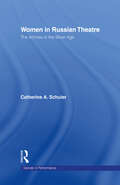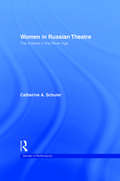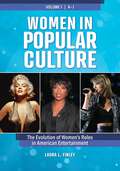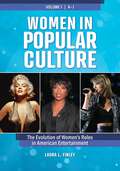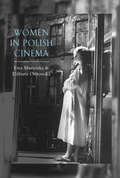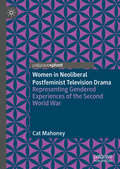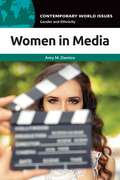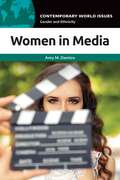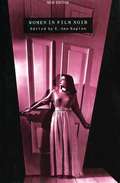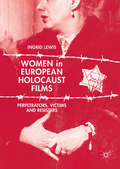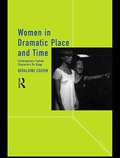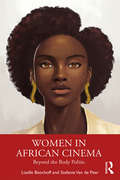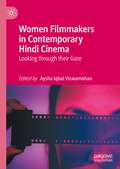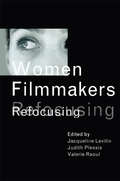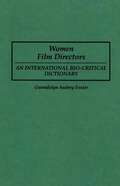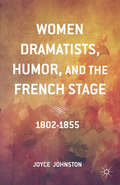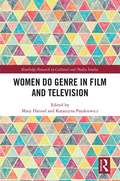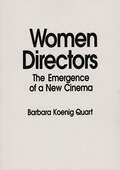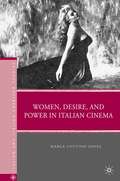- Table View
- List View
Women in Russian Theatre: The Actress in the Silver Age (Gender in Performance)
by Catherine SchulerWomen in Russian Theatre is a fascinating feminist counterpoint to the established area of Russian theatre populated by male artists such as Stanislavsky, Chekov and Meyerhold. With unprecedented access to newly-opened files in Russia, Catherine Schuler brings to light the actresses who had an impact upon Russian modernist theatre. Schuler brings to light the extradordinary lives and work of eight Russian actresses who flourished on the stage between the late nineteenth and early twentieth century.
Women in Russian Theatre: The Actress in the Silver Age (Gender in Performance)
by Catherine SchulerWomen in Russian Theatre is a fascinating feminist counterpoint to the established area of Russian theatre populated by male artists such as Stanislavsky, Chekov and Meyerhold. With unprecedented access to newly-opened files in Russia, Catherine Schuler brings to light the actresses who had an impact upon Russian modernist theatre. Schuler brings to light the extradordinary lives and work of eight Russian actresses who flourished on the stage between the late nineteenth and early twentieth century.
Women in Popular Culture [2 volumes]: The Evolution of Women's Roles in American Entertainment [2 volumes]
by Laura L. FinleyIncluding more than 300 alphabetically listed entries, this 2-volume set presents a timely and detailed overview of some of the most significant contributions women have made to American popular culture from the silent film era to the present day.The lives and accomplishments of women from various aspects of popular culture are examined, including women from film, television, music, fashion, and literature. In addition to profiles, the encyclopedia also includes chapters that provide a historical review of gender, domesticity, marriage, work, and inclusivity in popular culture as well as a chronology of key achievements.This reference work is an ideal introduction to the roles women have played, both in the spotlight and behind it, throughout the history of popular culture in America. From the stars of Hollywood's Golden Age to the chart toppers of the 2020s, author Laura L. Finley documents how attitudes towards these icons have evolved and how their influence has shifted throughout time. The entries and essays also address such timely topics as feminism, the #MeToo movement, and the gender pay gap.
Women in Popular Culture [2 volumes]: The Evolution of Women's Roles in American Entertainment [2 volumes]
by Laura L. FinleyIncluding more than 300 alphabetically listed entries, this 2-volume set presents a timely and detailed overview of some of the most significant contributions women have made to American popular culture from the silent film era to the present day.The lives and accomplishments of women from various aspects of popular culture are examined, including women from film, television, music, fashion, and literature. In addition to profiles, the encyclopedia also includes chapters that provide a historical review of gender, domesticity, marriage, work, and inclusivity in popular culture as well as a chronology of key achievements.This reference work is an ideal introduction to the roles women have played, both in the spotlight and behind it, throughout the history of popular culture in America. From the stars of Hollywood's Golden Age to the chart toppers of the 2020s, author Laura L. Finley documents how attitudes towards these icons have evolved and how their influence has shifted throughout time. The entries and essays also address such timely topics as feminism, the #MeToo movement, and the gender pay gap.
Women in Polish Cinema
by Ewa Mazierska Elzbieta OstrowskaPolish film has long enjoyed an outstanding reputation but its best known protagonists tend to be male. This book points to the important role of women as key characters in Polish films, such as the enduring female figure in Polish culture, the "Polish Mother," female characters in socialist realistic cinema, women depicted in the films of the Polish School, Solidarity heroines, and women in the films from the postcommunist period. Not less important for the success of Polish cinema are Polish women filmmakers, four of whom are presented in this volume: Wanda Jakubowska, Agnieszka Holland, Barbara Sass and Dorota Kędzierzawska, whose work is examined.
Women in Neoliberal Postfeminist Television Drama: Representing Gendered Experiences of the Second World War
by Cat Mahoney“In this insightful book, Cat Mahoney offers a fascinating analysis of contemporary TV dramas such as Home Fires, Land Girls and The Bletchley Circle. Developing the idea that history is told through the preoccupations of the present, she argues compellingly that these are postfeminist dramas which work through troubling ideas about heteronormative romance, domesticity, beauty and whiteness, while reinforcing the idea that feminism as a political movement is not necessary. A bold and original contribution to television studies, gender studies and popular history.” ̶ Rosalind Gill, City, University of London, UK By examining contemporary television drama set during and immediately after the Second World War, this book illustrates the ways in which postfeminism has shaped representations of women in contemporary culture. Mahoney offers a new perspective to debates that have previously been concerned with questions of historical accuracy. She argues that depictions of women from the past in modern television drama spawn from the neoliberal postfeminist media climate which originated in the 1990s. These depictions respond to a cultural need to naturalise and de-historicise a version of neoliberal postfeminist femininity that is compatible with the current media climate and far more reflective of the concerns of the present than any “real” or lived experience of women in the past. The result of this process of naturalisation is the assertion that postfeminist values are natural and eternal, rather than a product of the 1980s economic turn and the present political moment. By identifying and interrogating postfeminist norms within four television drama series produced since the 2008 financial crash, this book argues that postfeminism is a dominant structuring force in their depiction of female characters and of the past.
Women in Media: A Reference Handbook (Contemporary World Issues)
by Amy M. DamicoThis title provides a broad overview of how women are portrayed and treated in America's news and entertainment industries, including film, television, radio, the internet, and social media.This book provides a one-stop resource for understanding the participation and representation of women in the U.S. media in such areas as narrative film, scripted television programming, advertising, video games, news, and sports. Coverage is wide-ranging and comprehensive, covering historical developments and trends as well as such relevant issues as gender disparities in pay and advancement opportunities, stereotypical gender portrayals in popular entertainment, sexual harassment in America's media and entertainment industries, and the dearth of positive media representations of women of color.Engaging with this history and reading about current issues related to this topic will be useful to those interested in understanding more about why women's engagement in media—in such roles as performer, journalist, producer, and writer—is important. It will also help readers better understand how and why problematic media representations of women hinder efforts to achieve full gender equality in American society.
Women in Media: A Reference Handbook (Contemporary World Issues)
by Amy M. DamicoThis title provides a broad overview of how women are portrayed and treated in America's news and entertainment industries, including film, television, radio, the internet, and social media.This book provides a one-stop resource for understanding the participation and representation of women in the U.S. media in such areas as narrative film, scripted television programming, advertising, video games, news, and sports. Coverage is wide-ranging and comprehensive, covering historical developments and trends as well as such relevant issues as gender disparities in pay and advancement opportunities, stereotypical gender portrayals in popular entertainment, sexual harassment in America's media and entertainment industries, and the dearth of positive media representations of women of color.Engaging with this history and reading about current issues related to this topic will be useful to those interested in understanding more about why women's engagement in media—in such roles as performer, journalist, producer, and writer—is important. It will also help readers better understand how and why problematic media representations of women hinder efforts to achieve full gender equality in American society.
Women in Film Noir
by E. Ann KaplanThe first edition of 'Women in Film Noir' (1978) assembled a group of scholars and critics committed to understanding the cinema in terms of gender, sexuality, politics, psychoanalysis and semiotics. This edition is expanded to include further essays which reflect the renewed interest in Film Noir. Exploring 'neo-noir', postmodernism and other contemporary trends, new essays offer readings of, among others, 'Bound' and 'Basic Instinct', broadening the scope of the book to include questions of race and homosexuality.
Women in Film Noir
The first edition of 'Women in Film Noir' (1978) assembled a group of scholars and critics committed to understanding the cinema in terms of gender, sexuality, politics, psychoanalysis and semiotics. This edition is expanded to include further essays which reflect the renewed interest in Film Noir. Exploring 'neo-noir', postmodernism and other contemporary trends, new essays offer readings of, among others, 'Bound' and 'Basic Instinct', broadening the scope of the book to include questions of race and homosexuality.
Women in European Holocaust Films: Perpetrators, Victims and Resisters
by Ingrid LewisThis book considers how women’s experiences have been treated in films dealing with Nazi persecution. Focusing on fiction films made in Europe between 1945 and the present, this study explores dominant discourses on and cinematic representation of women as perpetrators, victims and resisters. Ingrid Lewis contends that European Holocaust Cinema underwent a rich and complex trajectory of change with regard to the representation of women. This change both reflects and responds to key socio-cultural developments in the intervening decades as well as to new directions in cinema, historical research and politics of remembrance. The book will appeal to international scholars, students and educators within the fields of Holocaust Studies, Film Studies, European Cinema and Women’s Studies.
Women in European Holocaust Films: Perpetrators, Victims and Resisters
by Ingrid LewisThis book considers how women’s experiences have been treated in films dealing with Nazi persecution. Focusing on fiction films made in Europe between 1945 and the present, this study explores dominant discourses on and cinematic representation of women as perpetrators, victims and resisters. Ingrid Lewis contends that European Holocaust Cinema underwent a rich and complex trajectory of change with regard to the representation of women. This change both reflects and responds to key socio-cultural developments in the intervening decades as well as to new directions in cinema, historical research and politics of remembrance. The book will appeal to international scholars, students and educators within the fields of Holocaust Studies, Film Studies, European Cinema and Women’s Studies.
Women in Dramatic Place and Time: Contemporary Female Characters on Stage
by Geraldine CousinFirst published in 1996. Routledge is an imprint of Taylor & Francis, an informa company.
Women in Dramatic Place and Time: Contemporary Female Characters on Stage
by Geraldine CousinFirst published in 1996. Routledge is an imprint of Taylor & Francis, an informa company.
Women in African Cinema: Beyond the Body Politic
by Lizelle Bisschoff Stefanie Van de PeerWomen in African Cinema: Beyond the Body Politic showcases the very prolific but often marginalised presence of women in African cinema, both on the screen and behind the camera. This study provides the first in-depth and sustained study of women in African cinema. Films by women from different geographical regions are discussed in case studies that are framed by feminist theoretical and historical themes, and seen through an anti-colonial, philosophical, political and socio-cultural cinematic lens. A historical and theoretical introduction provides the context for thematic chapters exploring topics ranging from female identities, female friendships, women in revolutionary cinema, motherhood and daughterhood, women’s bodies, sexuality, and spirituality. Each chapter serves up a theoretical-historical discussion of the chosen theme, followed by two in-depth case studies that provide contextual and transnational readings of the films as well as outlining production, distribution and exhibition contexts. This book contributes to the feminist anti-racist revision of the canon by placing African women filmmakers squarely at the centre of African film culture. Demonstrating the depth and diversity of the feminine or female aesthetic in African cinema, this book will be of great interest to students and scholars of African cinema, media studies and African studies.
Women in African Cinema: Beyond the Body Politic
by Lizelle Bisschoff Stefanie Van de PeerWomen in African Cinema: Beyond the Body Politic showcases the very prolific but often marginalised presence of women in African cinema, both on the screen and behind the camera. This study provides the first in-depth and sustained study of women in African cinema. Films by women from different geographical regions are discussed in case studies that are framed by feminist theoretical and historical themes, and seen through an anti-colonial, philosophical, political and socio-cultural cinematic lens. A historical and theoretical introduction provides the context for thematic chapters exploring topics ranging from female identities, female friendships, women in revolutionary cinema, motherhood and daughterhood, women’s bodies, sexuality, and spirituality. Each chapter serves up a theoretical-historical discussion of the chosen theme, followed by two in-depth case studies that provide contextual and transnational readings of the films as well as outlining production, distribution and exhibition contexts. This book contributes to the feminist anti-racist revision of the canon by placing African women filmmakers squarely at the centre of African film culture. Demonstrating the depth and diversity of the feminine or female aesthetic in African cinema, this book will be of great interest to students and scholars of African cinema, media studies and African studies.
Women Filmmakers in Contemporary Hindi Cinema: Looking through their Gaze
by Aysha Iqbal ViswamohanThis book is a comprehensive anthology comprising essays on women film directors, producers and screenwriters from Bollywood, or the popular Hindi film industry. It derives from the major theories of modernity, postmodern feminism, semiotics, cultural production, and gender performativity in globalized times. The collection transcends the traditional approaches of looking at films made by women filmmakers as ‘feminist’ cinema, and focuses on an extraordinary group of women filmmakers like Ashwini Iyer Tiwari, Bhavani Iyer, Farah Khan, Mira Nair Vijaya Mehta, and Zoya Akthar. The volume will be of interest to academics and theorists of gender and Hindi cinema, as well as anybody interested in contemporary Hindi films in their various manifestations.
Women Filmmakers: Refocusing
by Jacqueline Levitin Judith Plessis Valerie RaoulThis wide-ranging volume of new work brings together women filmmakers and critics who speak about what has changed over the past twenty years. Including such filmmakers as Margarethe von Trotta, Deepa Mehta, and Pratibha Parmar, and such critics as E. Ann Kaplan, this comprehensive volume addresses political, artistic, and economic questions vital
Women Filmmakers: Refocusing
by Jacqueline Levitin Judith Plessis Valerie RaoulThis wide-ranging volume of new work brings together women filmmakers and critics who speak about what has changed over the past twenty years. Including such filmmakers as Margarethe von Trotta, Deepa Mehta, and Pratibha Parmar, and such critics as E. Ann Kaplan, this comprehensive volume addresses political, artistic, and economic questions vital
Women Film Directors: An International Bio-Critical Dictionary (Non-ser.)
by Gwendolyn A. FosterUntil now, there hasn't been one single-volume authoritative reference work on the history of women in film, highlighting nearly every woman filmmaker from the dawn of cinema including Alice Guy (France, 1896), Chantal Akerman (Belgium), Penny Marshall (U.S.), and Sally Potter (U.K.). Every effort has been made to include every kind of woman filmmaker: commercial and mainstream, avant-garde, and minority, and to give a complete cross-section of the work of these remarkable women. Scholars and students of film, popular culture, Women's Studies, and International Studies, as well as film buffs will learn much from this work.The Dictionary covers the careers of nearly 200 women filmmakers, giving vital statistics where available, listings of films directed by these women, and selected bibliographies for further reading. This is a one-volume, one-stop resource, a comprehensive, up-to-date guide that is absolutely essential for any course offering an overview or survey of women's cinema. It offers not only all available statistics, but critical evaluations of the filmmakers' work as well. In order to keep the length manageable, this volume focuses on women who direct fictional narrative films, with occasional forays into the area of the documentary and is limited to film production rather than video production.
Women Dramatists, Humor, and the French Stage: 1802 to 1855
by J. JohnstonFilling a critical void, this book examines French women dramatists of the nineteenth-century who staged works prior to the lifting of censorship laws in 1864. Though none staged overtly feminist drama, Sophie de Bawr, Sophie Gay, Virginie Ancelot, and Delphine Girardin questioned patriarchal dominance and reconstructed ideals of womanhood.
Women Do Genre in Film and Television (Routledge Research in Cultural and Media Studies)
by Mary Harrod Katarzyna PaszkiewiczWinner of first Prize in the BAFTSS Best Edited Collection competition, this volume examines how different generations of women work within the genericity of audio-visual storytelling not necessarily to ‘undo’ or ‘subvert’ popular formats, but also to draw on their generative force. Recent examples of filmmakers and creative practitioners within and outside Hollywood as well as women working in non-directing authorial roles remind us that women are in various ways authoring commercially and culturally impactful texts across a range of genres. Put simply, this volume asks: what do women who are creatively engaged with audio-visual industries do with genre and what does genre do with them? The contributors to the collection respond to this question from diverse perspectives and with different answers, spanning issues of direction, screenwriting, performance and audience address/reception.
Women Do Genre in Film and Television (Routledge Research in Cultural and Media Studies)
by Mary Harrod Katarzyna PaszkiewiczWinner of first Prize in the BAFTSS Best Edited Collection competition, this volume examines how different generations of women work within the genericity of audio-visual storytelling not necessarily to ‘undo’ or ‘subvert’ popular formats, but also to draw on their generative force. Recent examples of filmmakers and creative practitioners within and outside Hollywood as well as women working in non-directing authorial roles remind us that women are in various ways authoring commercially and culturally impactful texts across a range of genres. Put simply, this volume asks: what do women who are creatively engaged with audio-visual industries do with genre and what does genre do with them? The contributors to the collection respond to this question from diverse perspectives and with different answers, spanning issues of direction, screenwriting, performance and audience address/reception.
Women Directors: The Emergence of a New Cinema
by Barbara QuartQuart here extends her previous writings on what she terms `the best narrative cinema: women-centered cinema' and feminist filmmaking. Quart addresses American, Western European, and Eastern European directors, closing with Third World examples. Arguing that independent filmmaking best serves the quest for a woman's voice and vision, Quart chronicles the survival of women directors. She traces a heritage of women directors inside the Hollywood system and beyond. . . . This excellent study . . . [is] recommended for undergraduates in film and women's studies. ChoiceThe current level of activity among women directors is unequalled in the history of feature films. This unprecedented study examines major contemporary women directors of narrative feature film--their themes, their art, and the circumstances under which they work. Quart contends that women are creating a film language and film sensibility that are unique, strong, and--until now--unexplored. Her discussion centers on the ties between women directors, rather than on a survey of women who direct films. Beginning with the antecedents to today's burgeoning number of women directors, the study progresses to American women directors. Subsequent chapters focus on womenn directors in Western Europe and Eastern Europe, with some attention as well to Asia and Latin America.
Women, Desire, and Power in Italian Cinema (Italian and Italian American Studies)
by M. Cottino-JonesWomen, Desire, and Power in Italian Cinema offers, for the first time in Italian Cinema criticism, a contextual study of the representation of women in twentieth-century Italian films. Marga Cottino-Jones argues that the ways women are depicted on screen reflects a subconscious "sexual conservatism" typical of an Italian society rooted within a patriarchal ideology. The book then follows the slow but constant process of social awareness in the Italian society through women in film, especially after the 1950s. Comprehensive in scope, this book analyzes the films of internationally known male and female directors, such as Antonioni, Fellini, Rossellini, Visconti, Bertolucci, Benigni, Cavani, Wertmuller, Comencini, and Archibugi. Special consideration is given to the actresses and actors that have become the icons of Italian femininity and masculinity, such as Sofia Loren, Gina Lollobrigida, Silvana Mangano, Gian Carlo Giannini, Marcello Mastroianni, and Alberto Sordi.
